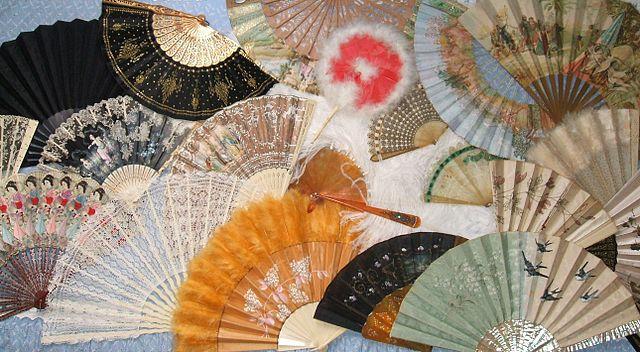During the 19th century, a woman’s freedom to communicate was severely limited due to the social conventions of that era. In contemporary times, it has become a popular belief that women developed a “secret” language using these fans, even as they became a popular fashion accessory.
However, many historians refute this idea, suggesting that it is little more than a romantic notion with no historical basis. True or not, the history of hand fans is a long and interesting one, and they are still quite popular in many places of the world today.
History
Rigid hand fans originated in the Far East (China, India, and Egypt) nearly 5,000 years ago, and were brought to Europe during the Crusades. They were produced for the European market primarily in France, although for Spain, abanicos (hand fans) also became an actual part of the culture there.
Folding fans were originally from Japan, and they also became quite popular in Europe.
Although most hand fans were originally designed for the practical purposes of cooling or repelling insects, and then as a popular fashion accessory, they were also eventually designed for many other reasons. For example: the commemoration of an important social/political event, political propaganda, advertisements, holiday reminders, and even maps; some had puzzles and/or riddles on them to make boring events more interesting.
Currently, hand fans are designed by several companies for weddings, souvenirs, gifts, commemoratives, and advertisements. Online companies specialize in custom designs, and there are some you can buy to stamp yourself. Ranging from paper to wood, simple to ornate, they are still quite popular throughout the world. Many of the world’s most ornate hand fans are on display in museums as genuine works of art.

Russian Eva Nansen (1858 - 1907) in concert dress, ca 1900. (Wolfenstein/National Library of Norway)
Secret Language
As for the “secret” language of the hand fan, many believe it may have been passed from woman to woman—even mother to daughter—for the purpose of communicating with each other in situations where conversation was not considered proper, as well as when faced with potential suitors in social situations.
During the Victorian age, women were expected at all times to conduct themselves very discreetly in public; any direct communication of feelings or emotions between men and women was considered particularly undesirable. This made it extremely difficult for a woman to make her wishes known regarding the acceptability of a particular suitor. Ultimately, the language of the hand fan allowed for a woman to convey her desires and feelings to the prospective suitors without betraying the strict code of social etiquette.
A 19th century fan-maker, Pierre Duvelleroy, recorded a language of the fan.
For instance, fanning slowly meant, “I am married,” or, fanning quickly, “I am engaged.” Twirling her fan in the right hand meant, “I love another.” Or, if the young man was of interest as a friend rather than a suitor, she might drop the fan, which communicated, “We will be friends.”




Friends Read Free